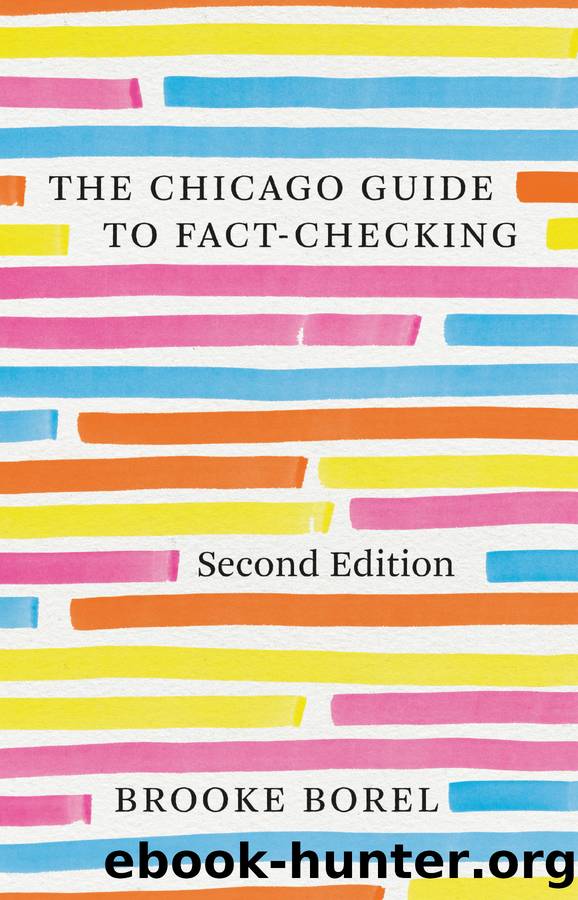The Chicago Guide to Fact-Checking, Second Edition by Brooke Borel;

Author:Brooke Borel; [Borel, Brooke]
Language: eng
Format: epub
Tags: LAN000000 LANGUAGE ARTS & DISCIPLINES / General, LAN008000 LANGUAGE ARTS & DISCIPLINES / Journalism, REF000000 REFERENCE / General, LAN005060 LANGUAGE ARTS & DISCIPLINES / Writing / Nonfiction (incl. Memoirs)
Publisher: University of Chicago Press
Published: 2023-05-23T00:00:00+00:00
Five ||| Sourcing
Fact-checking doesnât mean much if you arenât checking a story against solid sources. If youâre fact-checking someone elseâs work, the writer will ideally, though relatively rarely, provide sources for most or all of the story. When the writer does provide sources, you will need to evaluate those sources. This is a matter of experience and consideration. When the source material is lacking in quality or quantity, you will have two choices: (1) pester the writer to provide better materials (this may be especially necessary if the sources in question are interview transcripts and other materials you canât access) or (2) find relevant sources on your own.
Whether youâre in the position of evaluating a writerâs source material or finding your own, keep in mind the distinction between primary and secondary sources, and use primary sources whenever possible. Think of these as raw materialâthe original wellspring of information. Examples include eyewitness reports, government documents, diaries, letters and emails, photographs, interviews, speeches, audio and video recordings, and historical records.
Secondary sources, such as biographies and encyclopedias, build on primary sources and interpret or summarize them in some way. When a writer relies on secondary sources, dig up relevant primary materials to make sure the information wasnât lost in translation. For example, if a biography includes quotations from letters, contact the entityâperhaps a museumâthat has those documents. If you arenât able to do this, evaluate the biography and ask yourself whether or not you should trust it. Or, another way to treat this sort of material is to be sure to include the source in the text of the story, in order to provide transparency for the reader. Rather than stating something from the biography as fact, add, for example: âAccording to Walter Isaacsonâs biography of Steve Jobs . . .â
Be aware, though, that not all primary sources are necessarily of high quality or trustworthy, while some secondary sources have a high level of accuracy. When it comes to primary sources, an expert may have financial conflicts of interest that influence their perspective; an eyewitness to a crime might not fully remember the details; and an opinion poll may have shoddy methodology. High-quality secondary sources may include a well-done scientific analysis of multiple original studies, called a meta-analysis; a well-sourced and contextualized biography; and a historian relaying an anecdote about original papers they have analyzed from an archive. Also be aware that some sources can be either primary or secondary, depending on how they are used. A newspaper article, for example, may be primary if a writer used it to show that a particular event was covered by the press, while that same article could be secondary if the writer is using it to confirm a statistic.
Although the following list isnât exhaustive, it includes the categories of sources youâll encounter most often as a fact-checker. Some categories may include both primary and secondary sources. For example, a person who experienced or witnessed an event may be a primary source, but a reporter who wrote about that event will be a secondary source.
Download
This site does not store any files on its server. We only index and link to content provided by other sites. Please contact the content providers to delete copyright contents if any and email us, we'll remove relevant links or contents immediately.
The Hot Zone by Richard Preston(1983)
Rigor Mortis by Richard Harris(1681)
How Innovation Works by Matt Ridley(1596)
Oxymoronica by Dr. Mardy Grothe(1513)
Mawson's Will by Lennard Bickel(1417)
Kathryn Bowers & Barbara Natterson-Horowitz by Zoobiquity(1386)
The Future of the Mind: The Scientific Quest to Understand, Enhance, and Empower the Mind by Michio Kaku(1316)
THE DEMON HAUNTED WORLD by Carl Sagan(1296)
Bankrupting Physics by Alexander Unzicker(1292)
The End of Breast Cancer by Kathleen T. Ruddy MD(1277)
Statistics Done Wrong: The Woefully Complete Guide by Alex Reinhart(1268)
The Ghost Hunters by Deborah Blum(1260)
One Two Three ... Infinity: Facts and Speculations of Science by George Gamow(1219)
The Universe Speaks in Numbers by Graham Farmelo(1198)
Science Book by Big Ideas Simply Explained(1177)
The Wizards of Langley by Jeffrey T Richelson(1097)
Biomimicry by Janine M. Benyus(1080)
Rigor Mortis: How Sloppy Science Creates Worthless Cures, Crushes Hope, and Wastes Billions by Richard Harris(1055)
The Case Against Fragrance by Kate Grenville(1029)
